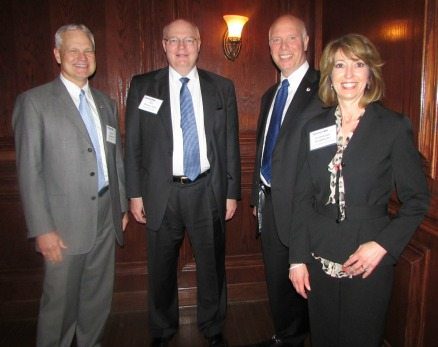
Earlier this month the WashingtonExec MARCOM Committee hosted an evening roundtable on the topic of rewriting the marketing playbook.
Eileen Cassidy Rivera, Vice President of Global Marketing and Communications at Harris Healthcare Solutions, moderated the discussion at Maggiano’s in Tyson’s Galleria.
Keynote speakers Dale Luddeke, Senior Vice President of Strategy and Business Growth at STG, Inc.; Ed Swallow, Vice President of Business Development at Northrop Grumman; and Don Renner, Vice President at L-3 Communications, shared their views on the importance of collaboration between Business Development and MARCOM leaders in government contracting firms.
Swallow emphasized, “A new normal is prevailing in the DC area – what worked the last few years in communications is not working today. We have to be more agile and use all channels to reach our customers and help them understand our message.”
Luddeke, Swallow, and Renner all brought different perspectives and knowledge to the discussion, but came to the same conclusion: business development leaders and MARCOM leaders need to continue building strong relationships with each other as well as with the operational and functional leaders in their organizations. Better results can be achieved by reaching deeper into the human capital element of marketing. Doing so better enables the multiplying effect of relevant messaging in and among an organization’s various client levels of interest.
“On behalf of the value-added solutions needed by our client base, we as industry need to be able to more quickly assess and evaluate the lines of business where genuine value-add can be delivered and for those that are a stretch… then we have to be able to say that is not our capability at this time,” said Renner. “This presents a more valued effort for both our client base and our share-holders which both equally expect results.”
Together, MARCOM and Business Development leaders must continue to pull resources and focus on delivering maximum value to clients and those employees working directly with the client. As the federal government makes deep spending cuts, contractors must now work even more diligently to invest in better opportunity development activities that will help stretch their organizations into new areas of potential growth.
“It is a matter of balancing the business portfolio,” said Luddeke. “Leaders must develop a collaborative decision-making framework that strategically considers potential markets and new opportunities through a prism of what they see as core (stable) and what they deem as stimulating (disruptive).”
All attendees agreed that in times of austerity, building strong professional relationships with clients as well as industry partners is critical for sustaining corporate growth in a contracting market place.
Corrine Gormont, Vice President of Marketing Communications at L-3 Communications sponsored the roundtable.
Previous meeting topics for the WashingtonExec MARCOM Committee have included New Trends in Traditional Messaging; Digital Communications: From Strategy to Execution; Sequestration: Messaging and Strategy; Content Generation; Employee Engagement/Internal Communications; Government Relations; Demystifying Going Digital; and The Strategic Relationship Between MARCOM/Communications Professionals and the Company CFO: Is it a Money Thing?.


